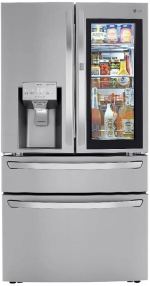Refrigerator Troubleshooting Guide
A Place for Refrigerator Appliance Troubleshooting
Refrigerator troubleshooting can be a hit or miss kind of a thing but it’s still worth trying to do before calling a repairman. It's embarrassing is to call a repairman and find out you could have taken care of it with just a bit of appliance troubleshooting first.
Having to pay someone to come out and plug in your refrigerator or take care of a tripped breaker isn’t just embarrassing it’s costly too!
We've listed a few questions and answers we receive fairly often regarding refrigerator troubleshooting.
If you are looking for Whirlpool refrigerator troubleshooting, Kenmore refrigerator troubleshooting or GE refrigerator troubleshooting each of these companies, and many others, intentionally put a refrigerator troubleshooting section in your refrigerator owner’s manual.
This manual is your best bet because each refrigerator is made differently and may have variables that aren’t considered in our guide.
My refrigerator isn’t running and the light won’t come on:
- Is it securely plugged in? Meaning is the plug all of the way in the wall? You'd be surprised how many times a simple SHIFT of the refrigerator causes it to dislodge from the plug. Very few people think to check this (thinking there's no WAY they couldn't have thought of that!)
- If you can easily move your refrigerator, (typically there are locks on the front wheels that can come undone) then check to see that the outlet it is plugged into has power coming through it.
(If you are moving your refrigerator on a wood floor make sure you cover the floor first with cardboard before moving it.
We’ve learned the hard way that the wheels can damage a wood floor. Refrigerator troubleshooting doesn't have to ruin your floor.)
The seemingly safest way to do this is with an electrical pen tester. Turn it on, put it in the outlet and it should light up and chirp if there is electricity in it.
- While you’ve got your refrigerator out, check the cord to see if it is nicked or damaged in any way.
- If you are using an extension cord then you should try to find a way to get rid of it as this can also be your problem.
If you can’t then test the extension cord on something simple like a clock to see if it is still working.
- If you feel comfortable with dealing with electricity then you can check the voltage of the outlet to make sure it is in an acceptable range.
Check your circuit box for a tripped breaker or fuse that has blown.
My refrigerator isn’t running but the light comes on when I open the door:
- What's the set temperature of your refrigerator? If you are lucky enough to have a digital readout on your refrigerator and freezer’s temperatures then you should be looking for anywhere from 5 to 0 degrees Fahrenheit for the freezer and around 37 to 38 degrees Fahrenheit for the fridge.
TIP: If you're trying to do refrigerator troubleshooting on the internal refrigerator temperature and don’t have a digital temperature display then place a cooking thermometer in a cup of water in your refrigerator for a few hours and read it.
The way to test your freezer is to replace the water with any cooking oil or alcohol.
- If you find that your freezer is cold but your fridge isn’t working. This is a sign that the vents that go from the freezer to the refrigerator aren’t opening properly as the freezer is typically where a refrigerator gets it’s cool air from.
- Is there proper airflow around your refrigerator? Typically there should be 3” between it and the cabinets and walls (except of course if it’s a built-in). You’ll also want at least 1” above the top to help with the airflow.
- Try cleaning the condenser coils. The first question is typically, “Where are they located?” There are two possible spots: behind the refrigerator or at the bottom near the floor. If you haven’t cleaned your coils recently you should be doing once a year for the rear coils and twice a year for the floor coils.
First unplug your refrigerator before starting this project regardless of your coils’ location. Careful when moving the refrigerator as this isn’t usually a job for one person. If it’s on wheels and you can unlock them easily then you can try it alone. Either way, never tilt the refrigerator forward to clean back there. It can cause an awful mess and can be bad for your refrigerator.
For a floor level coil refrigerator troubleshooting, remove the grill in front of them. It should come off easily but if it doesn’t look for clips or screws holding it in place. Just don’t pull too hard as they can break easily.
Once you’ve got access to the coils then attach your want attachment to your vacuum and get rid of anything on the coils including dust, lint or debris.
- After trying all of these the next step is to unplug your fridge and wait a few hours. Then when you plug it back in it starts working you now know that something is causing your compressor to overheat.
- If you’ve gotten this far and still found nothing, you can check the following things:
- Temperature Control
- Evaporator Fan
- Defrost Timer
- Compressor Relay
- Overload Protector
- Compressor Motor
As we aren’t refrigerator repair specialists we don’t feel comfortable giving you explicit details on how to do these tests but there are many sites online that do.
The light in my refrigerator doesn’t work:
We’re happy to say that this one is easy.
- Try replacing the bulb to see if it’s just a blown bulb.
- If it’s not the bulb then check the switch on the door. Whether or not it is depressed makes the difference on whether or not the light will come on.
My refrigerator just won’t get cold enough:
Let’s start simple and get more complex.
- Is the temperature control set low enough? Set it lower and check to see if it makes a difference. If you’re not sure, place a cooking thermometer in a cup of water left in your fridge for a few hours. Read the temperature, lower the setting and check the thermometer again in a few hours.
- Is anything in the refrigerator blocking the internal air flow? Sometimes you can place something large like a gallon of milk and the air won’t flow properly leaving the fridge to feel warm. This may be a good trick if you are looking for Whirlpool refrigerator troubleshooting as we’ve had a few complaints about this from our visitors.
- Check to see if the door seals are sealing when closed or is cool air getting out?
- Are the air vents in your refrigerator blocked by anything?
At this point it again gets more technical and you’ll need to check:
- Temperature Control
- Condenser Coils
- Door Switch
- Defrost heater
- Defrost timer
- Evaporator Fan
- Clogged Drain tube
- Leaking refrigerant
My fridge is just too cold (either one or both the freezer or fridge):
- Check the temperature setting. Decrease it and see what happens. Also, if things are freezing up only in certain areas one great refrigerator troubleshooting tip is to take a look if the items are right next to a vent to the freezer. If so, give it a bit of space.
- Test your temperature control to see if it’s properly working.
My fridge is making sounds or is really noisy:
- If you are hearing things like popping or even hissing and your refrigerator is a frost free one, it’s probably the defrost heater doing it’s job.
- The fridge might not be level which can be causing the noise.
- Drain Pan
- Condenser Fan
- Evaporator Fan
- Compressor Mounts
My refrigerator never stops running:
- Start by defrosting your freezer.
- Clean the coils (see above for details on how to do this).
- Check to see that your door seals are still sealing. If they aren’t it can cause a constant leak of cool air and in turn make your refrigerator have to keep on working to cool it.
- One other possibility can be that you just filled it up or just changed the temperature which can cause a 24 hour cycle to get the fridge cool. This can also be an issue in a humid area.
My fridge smells:
- Get rid of any food that has gone bad.
- Empty your refrigerator and thoroughly clean it out with a baking soda and hot water solution.
- Make sure your door seals are clean as well.
If these suggestions don’t work then the next step is to check your breaker strips. Once removed you’ll need to look for wet insulation. Though this isn’t something we would recommend do yourself unless you are very handy. The reason why has more to do with the fact that these panels can be a bit brittle and can break easily.
Recent Articles
-
Top 10 Refrigerators 2025 - Editor's Picks and Reviews
Jun 24, 25 03:58 AM
Discover the Top 10 Refrigerators 2025. Our editors rank the best models for every budget, kitchen size and style -- and help you find the best price. -
LG, Bottom Freezer, LDC22720ST
May 02, 24 01:00 AM
Bought an LG Bottom freezer refrigerator from a well known explanation point department store. And purchased the 10 year warranty for major components. -
Is it safe to set a full size refrigerator on carpet?
Jan 18, 24 05:18 PM
I have a full size refrigerator with top freezer. Is it safe to run it setting on a carpeted floor, if not what can I put under it? The unit is brand


New! Comments
Have something to say about what you just read? Leave a comment in the box below.